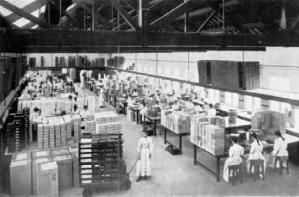Cadbury, the global leader in the chocolate confectionery market, began in 1824 when a young Quaker named John Cadbury opened up a shop in Birmingham. John sold coffee, tea, drinking chocolate and cocoa at his shop. Believing that alcohol was a main cause of poverty, John hoped his products might serve as an alternative. He also sold hops and mustard. Like many Quakers John had high quality standards for all of his products.
At that time in England, Quakers were prohibited from attending university, since it was affiliated with the established church, and their pacifist beliefs kept them from joining the military. With few opportunities available, Quakers often went into business-related fields and/or devoted their time to missions of social reform.
By 1842 John was selling 11 kinds of cocoa and 16 kinds of drinking chocolate. Soon John’s brother Benjamin joined the company to form Cadbury Brothers of Birmingham. The Cadbury brothers opened an office in London and received a Royal Warrant (one of many) as manufacturers of chocolate and cocoa to Queen Victoria in 1854. Six years later the brothers dissolved their partnership because of John’s failing health and the death of his wife. They left the business to John's sons George and Richard. John devoted the rest of his life to social work and died in 1889.

Packing room at Cadbury's Bournville factory.
George and Richard continued to expand the product line, and by 1864, they were pulling a profit. Cadbury’s Cocoa Essence, which was advertised as "absolutely pure and therefore best," was an all-natural product made with pure cocoa butter and no starchy ingredients. Cocoa Essence was the beginning of chocolate as we know it today. The brothers soon moved their manufacturing operations to a larger facility four miles south of Birmingham. The factory and area became known as Bournville.
With Cadbury’s continued success in chocolate, George and Richard stopped selling tea in 1873. Master confectioner Frederic Kinchelman was appointed to share his recipe and production secrets with Cadbury workers. This resulted in Cadbury producing chocolate covered nougats, bonbons delices, pistache, caramels, avelines and more. Cadbury manufactured its first milk chocolate in 1897. Two years later the Bournville factory employed 2,600 people and Cadbury was incorporated as a limited company.
During World War I, more than 2,000 of Cadbury’s male employees joined the Armed Forces. Cadbury supported the war effort, sending warm clothing, books and chocolate to the soldiers. Cadbury supplemented the government allowances to the dependants of their workers. When the workers returned, they were able to return to work, take educational courses, and injured or ill employees were looked after in convalescent homes. During this period trade overseas increased, and Cadbury opened its first overseas factory near Hobart, Tasmania. The next year Cadbury merged with JS Fry & Sons, a past market leader in chocolate.
Cadbury supported the war effort during World War II by converting parts of its factory into workrooms to manufacture equipment like milling machines for rifle factories and parts like pilot seats for Defiant fighter planes. Workers plowed football fields to grow crops, and the Cadbury St. John’s Ambulance unit helped people during air raids. Chocolate was considered essential for the Armed Forces and civilians. Rationing finally ended in 1949.
In 1969 Cadbury merged with Schweppes to form Cadbury Schweppes. Schweppes was a well-known British brand that manufactured carbonated mineral water and soft drinks. The merged companies would go on to acquire Sunkist, Canada Dry, Typhoo Tea and more. Schweppes Beverages was created, and the manufacture of Cadbury confectionery brands was licensed to Hershey.
Today Cadbury Schweppes is the largest confectionery company in the world, employing more than 70,000 employees. In 2006 the company had over $15 billion in overall sales. In March of 2007, Cadbury Scheweppes announced that it intends to separate its confectionery and beverage businesses. With almost 200 years in the business, Cadbury Schweppes will continue to prosper in the coming decades.
Cadbury Product Timeline



1865 – Cadbury Cocoa Essence 1875 – Cadbury Easter Eggs 1897 – Cadbury Milk Chocolate 1905 – Cadbury Dairy Milk 1908 – Cadbury Bournville Chocolate 1915 – Cadbury Milk Tray 1920 – Cadbury Flake 1923 – Cadbury Crème Eggs 1929 – Cadbury Crunchie 1938 – Cadbury Roses 1948 – Cadbury Fudge 1968 – Cadbury Picnic 1960 – Cadbury Buttons 1970 – Cadbury Curly Wurly 1983 – Cadbury Wispa 1985 – Cadbury Boost 1987 – Cadbury Twirl 1992 – Cadbury Timeout 1996 – Cadbury Fuse 2001– Cadbury Brunchbar, Dream & SnowFlake
Interesting Facts about Cadbury
In order to add products to your wishlist, please log in to your account.
